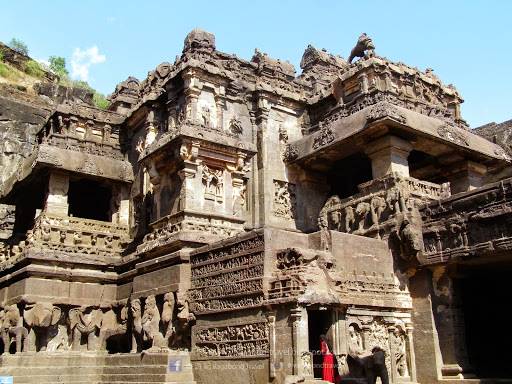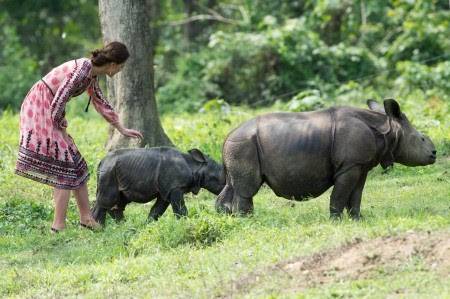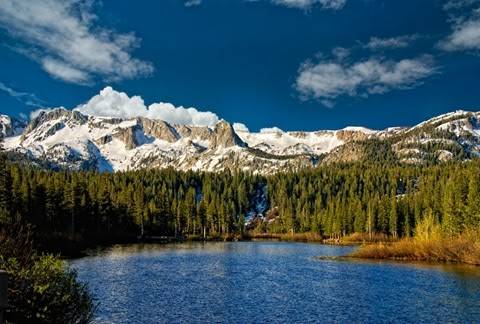The red Agra Fort, adjacent to the Taj Garden, is an important Mughal dynasty monument from the 16th century. It is a sturdy fortress built of red sandstone, with walls stretching 2.5 kilometers, enclosing the palaces of the Mughal rulers. Inside the fort, there are many palaces that resemble fairy tales, such as the Jahangir Palace or Khas Mahal built by Shah Jahan, the Diwan-i-Khas audience hall, and two very beautiful mosques.
The initial Buddhist caves at Ajanta were constructed between the 2nd century BCE and the 1st century BCE. During the Gupta period in the 5th to 6th centuries CE, more elaborately decorated caves were added to the original group. The paintings and sculptures of the Ajanta Caves are classic works of Buddhist art and hold significant artistic influence.
Ellora Caves
The Ellora Caves are located in Maharashtra, not far from Aurangabad. Carved into the high, steep basalt cliffs, 34 cave temples are lined up one after another, extending over 2000 meters. These well-preserved and orderly ruins date back to 600 to 1000 AD, vividly and perfectly recreating ancient Indian civilization. The Ellora Caves are not only unique in artistic design and superb in technical level, but also, as sanctuaries of Buddhism, Brahmanism, and Jainism, they embody the spirit of tolerance and forgiveness characteristic of ancient India.
Konark Sun Temple
The Konark Sun Temple is located on the coast of the Bay of Bengal, bathed in the rising sun. The temple is built in the shape of the chariot of the sun god Surya. The 24 wheels are adorned with character patterns, and the chariot is pulled by six horses. This temple, built in the 13th century, is one of the most famous Brahmin temples in India.
Kaziranga National Park is located in the central region of Assam, India, and is one of the last areas in eastern India that remains undisturbed by human activities. The park is home to the world's largest population of one-horned rhinoceroses, as well as many other mammals including tigers, elephants, leopards, bears, and thousands of birds.
Keoladeo National Park is located in Maharaja. Previously a duck hunting area, it is now an important wintering ground for a large number of waterfowl. These waterfowl come from Afghanistan, Turkmenistan, China, and Siberia. A total of 364 bird species have been recorded in the park, including the rare Siberian crane.
Goa was the capital during the Portuguese occupation of India. The churches and monasteries there, especially the Basilica of Bom Jesus which houses the tomb of St. Francis Xavier, are historical testimonies to the spread of the Christian gospel in Asia. These buildings have had a significant influence on the spread of Manueline, Mannerist, and Baroque architectural styles in all missionary countries in Asia.
Fatehpur Sikri (City of Victory) was built by Emperor Akbar in the latter half of the 16th century. It served as the capital of the Mughal Empire for only about ten years. The overall architecture and temples in the city follow a unified architectural style, including Jama Masjid, the largest mosque in India.
Elephanta Caves
Known as the 'City of Caves', Elephanta is located on an island near the Mumbai harbor in the Arabian Sea. The caves house a large collection of stone sculptures dedicated to the worship of Shiva. Through the artworks in the caves, especially the large reliefs in the main cave, Indian art is showcased in its most perfect form.
Khangchendzonga National Park
Khangchendzonga National Park is located in the heart of the Himalayas in northern India (State of Sikkim). It includes a variety of unique plains, valleys, lakes, glaciers, and spectacular snow-capped mountain ranges covered with pristine forests, including the world's third-highest peak, Mount Khangchendzonga. Many myths are associated with this mountain and various natural elements (such as caves, rivers, lakes, etc.). These stories and the sacred significance of practical practices have been integrated with Buddhist beliefs and form the basis recognized by the indigenous people of Sikkim.
Rani-ki-Vav (the Queen's Stepwell) at Patan, Gujarat
Apart from its artistic value, the Queen's Stepwell in India also had significant practical value at the time. The structure is divided into two main parts: one end is a cylindrical well, and the other end is a rectangular 'tank' connected to it. A notch was left on the well wall at the end near the 'tank', allowing the well water to automatically flow into the 'tank'. The well has a diameter of 10 meters and a depth of 30 meters, with layers of sculptures adorning the inner walls. To the east of the well is the rectangular 'tank', which is 69 meters long and 22 meters wide, with steps descending layer by layer. Although the Queen's Stepwell in India has suffered some damage, it still holds great historical significance. It was listed as a UNESCO World Heritage Site in 2014.

























